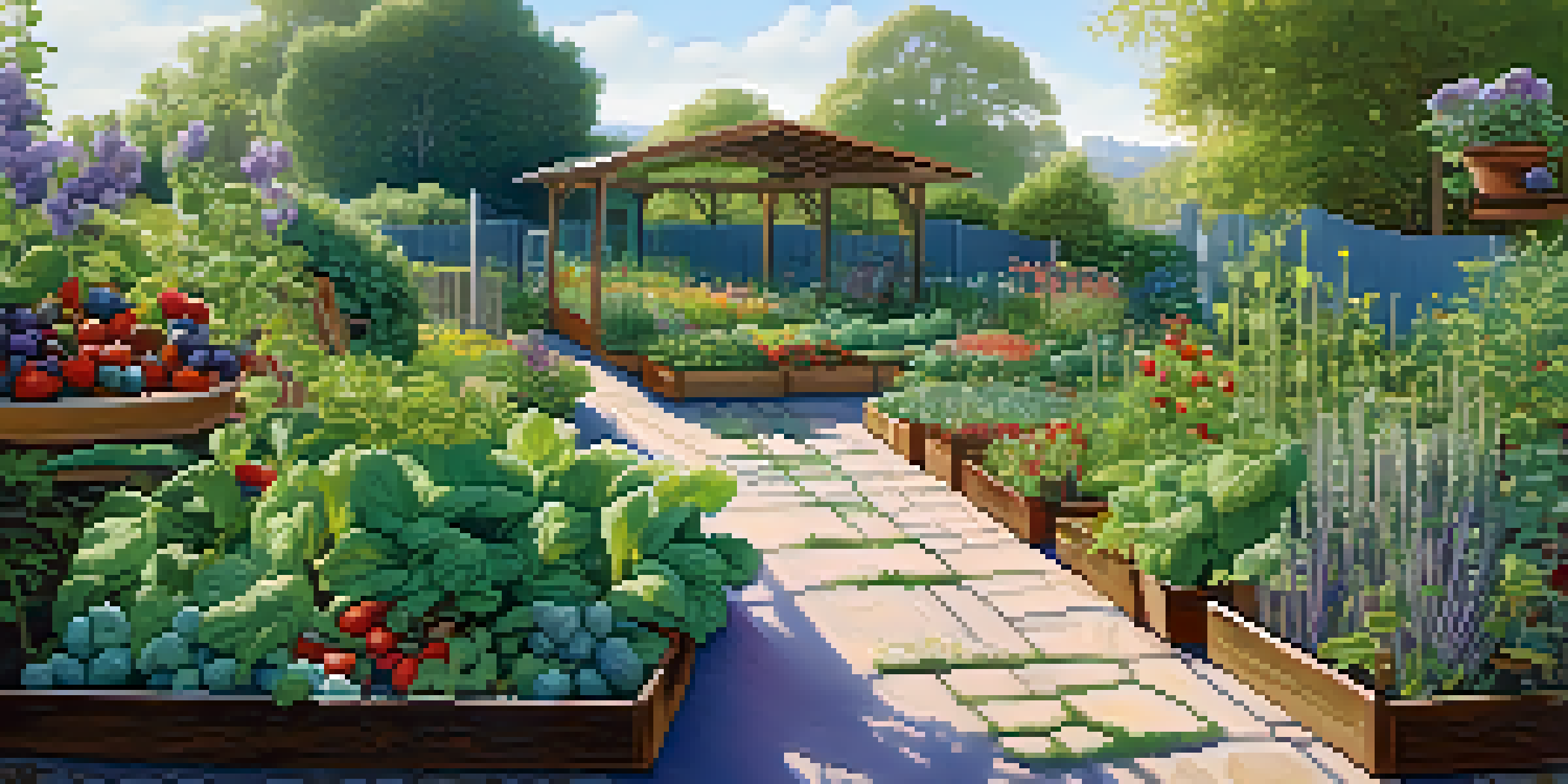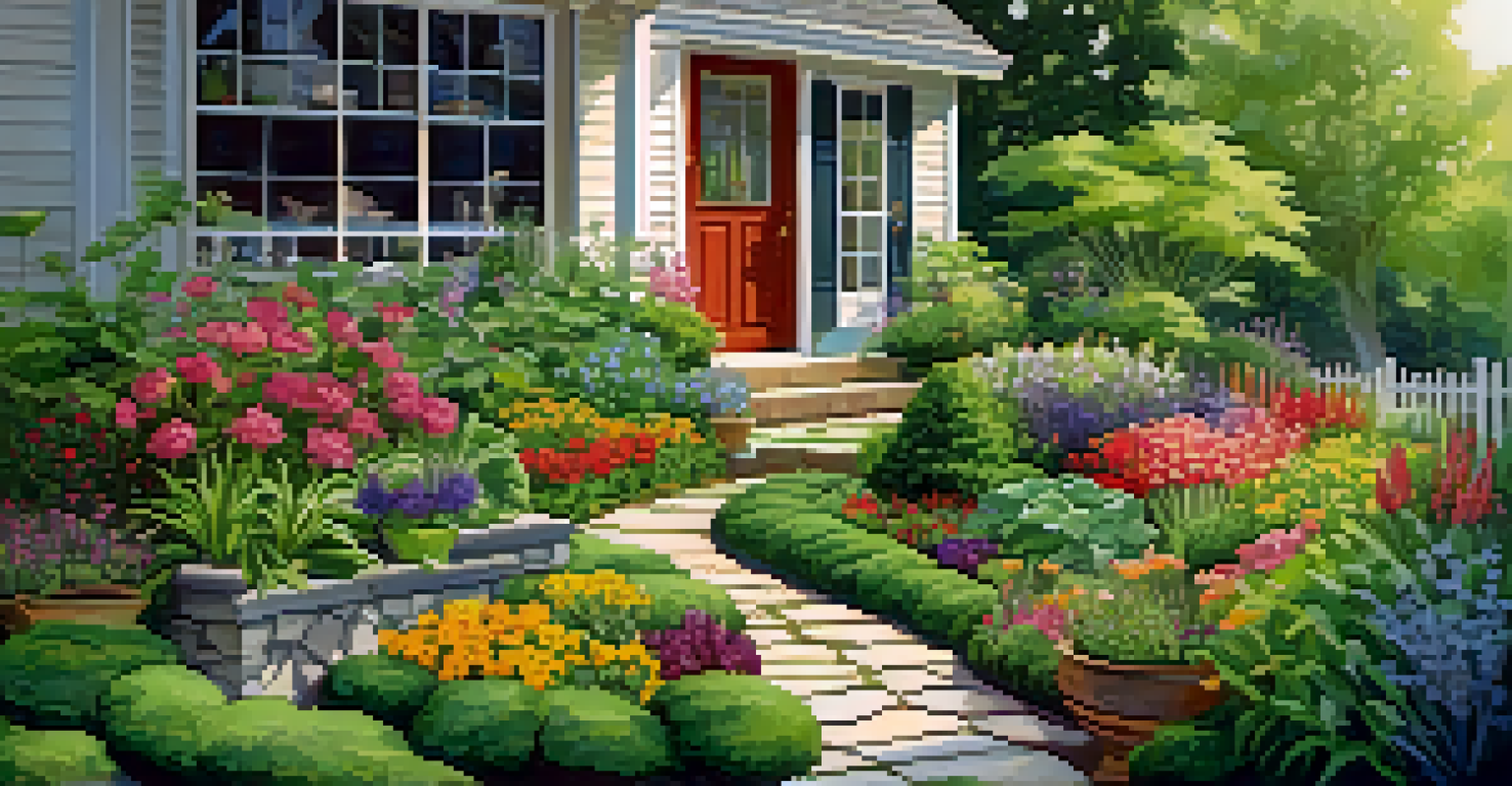Edible Landscaping: Combining Aesthetics with Sustainability

What is Edible Landscaping and Its Importance?
Edible landscaping is the practice of incorporating edible plants into your landscape design. This approach not only beautifies your garden but also provides a sustainable source of food. Imagine walking through a garden filled with colorful fruits and vegetables, instead of just ornamental plants; it’s a feast for the eyes and the palate.
The greatest gift of the garden is the restoration of the five senses.
This practice has gained popularity as more people seek to connect with nature while being conscious of sustainability. By growing your own food, you reduce the carbon footprint associated with transporting produce. Furthermore, it encourages biodiversity by attracting beneficial insects and wildlife, creating a thriving ecosystem right in your backyard.
In essence, edible landscaping is about merging functional and aesthetic elements in a way that benefits both you and the environment. It challenges the traditional view of gardening, inviting us to rethink how we use our outdoor spaces to nourish not just our bodies, but also our planet.
Choosing the Right Plants for Your Landscape
Selecting the right plants is crucial in edible landscaping. Consider both aesthetics and functionality when choosing what to grow. For example, vibrant fruits like strawberries and blueberries can serve as beautiful ground cover, while herbs like lavender and rosemary add fragrance and texture to your garden design.

Seasonality is another key factor to keep in mind. Opt for a mix of perennial plants, which come back year after year, and annuals that can be rotated based on the season. This not only ensures a year-round harvest but also keeps your landscape visually interesting throughout different times of the year.
Edible Landscaping Enhances Beauty
Incorporating edible plants into your landscape design creates a visually appealing garden while providing a sustainable source of food.
It's also wise to choose plants that thrive in your local climate. Native edibles not only require less maintenance but also support local wildlife. By aligning your plant choices with your environment, you'll create a sustainable garden that flourishes naturally.
Designing Your Edible Landscape for Aesthetic Appeal
A well-designed edible landscape harmonizes beauty and function. Start by mapping out your space, considering the sun exposure and soil quality in different areas. This allows you to place plants where they’ll thrive while creating visual interest with varying heights and colors.
To plant a garden is to believe in tomorrow.
Incorporate elements like paths, raised beds, and trellises to guide the eye and provide structure. For instance, climbing plants like beans or cucumbers on a trellis can create a stunning vertical garden that catches attention. Layering plants based on their height and spread can also enhance the overall visual appeal.
Don’t forget about seasonal changes; incorporating plants that bloom at different times will keep your landscape lively throughout the year. This thoughtful design approach can transform any outdoor space into a picturesque edible paradise.
The Benefits of Growing Your Own Food
Growing your own food through edible landscaping has numerous benefits, starting with the freshness of your produce. There’s nothing quite like picking a ripe tomato or a handful of herbs right from your garden. This not only elevates the flavor of your meals but also encourages healthier eating habits.
Additionally, cultivating your own food can significantly reduce your grocery bills. Once established, many edible plants will yield harvests year after year with minimal costs involved. This aspect makes edible landscaping a financially savvy choice for many households.
Choose Plants for Function and Aesthetics
Selecting the right mix of perennial and annual plants ensures a beautiful and productive garden that thrives in your local climate.
Moreover, gardening can be a therapeutic activity. Spending time outdoors, tending to plants, and watching them grow can reduce stress and improve overall well-being. It’s not just about the food; it’s about the joy and fulfillment that gardening brings into your life.
Sustainable Practices in Edible Landscaping
Incorporating sustainable practices into your edible landscape is key to its success. Start by using organic methods to cultivate your plants, avoiding harmful pesticides and fertilizers. This approach not only protects your health but also the environment, promoting a balanced ecosystem in your garden.
Water conservation techniques, such as drip irrigation and mulch, can help maintain moisture levels while reducing waste. By collecting rainwater or using greywater systems, you can further enhance your garden’s sustainability. These practices ensure that your landscaping remains eco-friendly and viable in the long term.
Finally, consider companion planting, where certain plants are grown together to naturally deter pests or enhance growth. This method not only reduces the need for chemicals but also fosters a diverse and resilient garden ecosystem.
Maintenance Tips for a Thriving Edible Landscape
Maintaining an edible landscape doesn’t have to be overwhelming. Start with a regular schedule for watering, pruning, and harvesting. Setting aside time each week to check on your plants can help you catch any issues early, ensuring a healthy garden.
Mulching is a great way to minimize weeds and retain moisture in the soil. Organic mulches, like straw or wood chips, not only suppress weeds but also add nutrients back into the earth as they decompose. This can save you time and effort in the long run.
Sustainable Practices Support Growth
Using organic methods, water conservation, and companion planting in your edible landscape fosters a healthy ecosystem and ensures long-term viability.
Lastly, be patient and flexible. Not every plant will flourish as expected, and that’s okay. Embrace the learning process and adapt your care routines as you discover what works best for your unique environment.
Inspiring Examples of Edible Landscaping
Many communities have embraced edible landscaping, creating stunning examples of beauty and sustainability. Community gardens, for instance, often showcase a variety of edible plants while fostering a sense of togetherness and cooperation among residents. These spaces not only beautify urban areas but also provide fresh produce to those in need.
Homeowners are also getting creative, transforming their front yards into edible paradises. Imagine walking past a house with a vibrant vegetable garden instead of just a patch of grass; it’s a refreshing sight that inspires others to rethink their landscapes. These innovative designs serve as a powerful reminder of how we can merge function with aesthetics.

Even public spaces are joining the movement, with parks incorporating edible plants into their designs. This trend not only educates visitors about sustainable practices but also encourages them to engage with their environment in a meaningful way. Such examples illustrate the endless possibilities of edible landscaping in our communities.